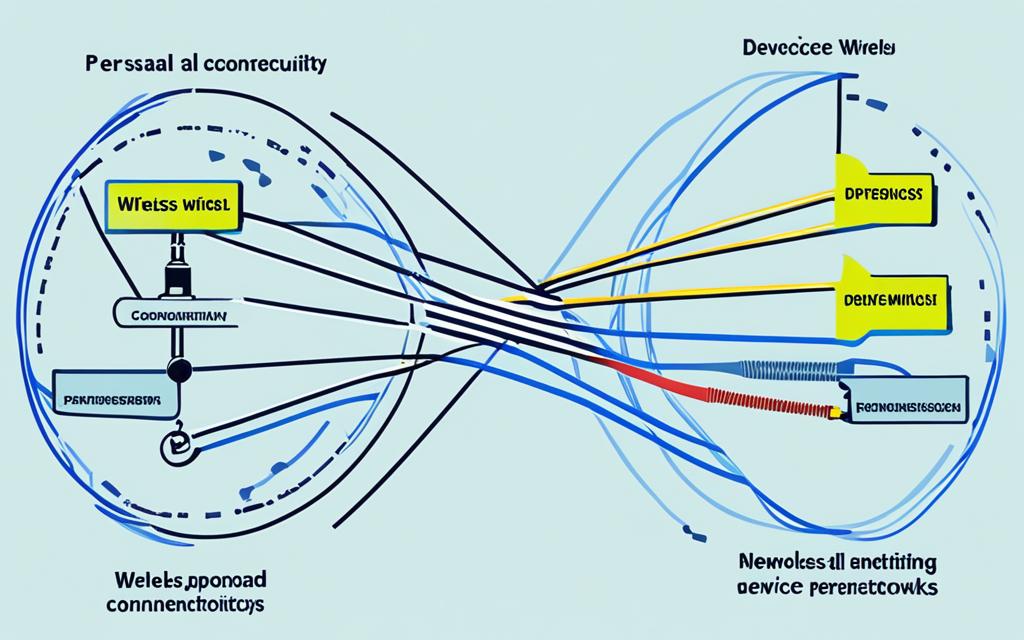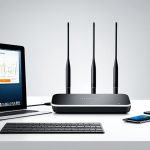Personal Area Networks (PANs) are essential for seamless connectivity within short-range networks. These networks link electronic devices and enable data and resource sharing, creating a cohesive and efficient workspace. However, to effectively navigate PANs, it is crucial to understand the various standards and protocols that govern them.
In this article, we will explore the PAN standards and protocols that form the backbone of these networks, allowing for smooth communication and connectivity between devices. By gaining a comprehensive understanding of PAN standards and protocols, you can optimize the performance and functionality of your PAN.
Stay tuned as we delve into the world of PANs and discover the wireless standards, wired vs. wireless PANs, range and capabilities of PAN devices, the role of Bluetooth in PANs, and much more. By the end of this article, you’ll have a clear understanding of how PAN standards and protocols shape the connectivity landscape, empowering you to make informed decisions regarding your personal network.
Understanding Wireless Standards in PANs
Wireless Personal Area Networks (WPANs) use various wireless standards to connect devices within a short range. These standards play a crucial role in facilitating seamless connectivity and data transfer in PANs. Let’s explore the key wireless standards used in PANs.
Bluetooth
Bluetooth is a widely known and used wireless standard in PANs. It enables devices to connect and communicate wirelessly over short distances, typically up to 10 meters. Bluetooth technology has evolved over time, giving rise to two main versions: Classic Bluetooth and Bluetooth Low Energy (BLE).
Classic Bluetooth is commonly found in consumer electronics devices, such as smartphones, laptops, and speakers. It allows for data transfer at higher rates and supports a wide range of applications, including file sharing and audio streaming.
On the other hand, Bluetooth Low Energy (BLE) is designed for low power consumption and small data transfer applications. BLE is becoming increasingly popular in PANs involving wearable devices, healthcare monitoring solutions, and IoT applications. It offers efficient and long-lasting connectivity, making it ideal for devices that operate on limited power sources.
Wi-Fi
Wi-Fi, another widely used wireless standard, provides high-speed data transfer and broader coverage compared to Bluetooth. It is commonly used in PANs where devices require faster internet connectivity, such as in offices or homes. Wi-Fi allows seamless connectivity between devices within the same PAN, enabling efficient data sharing and internet access.
Zigbee
Zigbee is an emerging wireless standard based on the IEEE 802.15.4 standard. It is gaining popularity in advanced WPANs where low power consumption and reliable data transfer are essential. Zigbee technology enables the creation of robust PANs, suitable for applications such as home automation, smart lighting, and industrial monitoring.
Overall, the selection of a wireless standard for a PAN depends on factors such as power consumption, data transfer requirements, and the intended use of the network. Different standards offer unique advantages and cater to specific PAN applications.
| Wireless Standard | Range (Approx.) | Data Transfer Speed | Power Consumption | Application Examples |
|---|---|---|---|---|
| Bluetooth | 10 meters | Varies (Classic Bluetooth: up to 3 Mbps, BLE: up to 1 Mbps) | Varies (Classic Bluetooth: higher power consumption, BLE: low power consumption) | Smartphones, speakers, wearable devices |
| Wi-Fi | Up to 100 meters | Varies (Depends on Wi-Fi standard) | Higher power consumption | Internet access, data-intensive applications |
| Zigbee | Up to 100 meters | 250 Kbps | Low power consumption | Home automation, industrial monitoring |
The table above provides a summary of the key wireless standards used in PANs, highlighting their range, data transfer speeds, power consumption, and application examples.
Wired vs. Wireless PANs
When it comes to Personal Area Networks (PANs), there are two primary categories: wired and wireless networks. Both types offer distinct advantages and are suited for different applications. Let’s explore the differences between these two options and understand how they fit into the broader PAN landscape.
Wired PANs: Reliable and Fast
Wired PANs utilize physical connections such as USB or Ethernet cables to establish network connections. These wired connections offer several benefits, including faster data transfer rates and more stable connections. Wired PANs are the go-to choice for applications that prioritize reliability and speed.
USB connections, for example, are commonly used to connect devices like smartphones, tablets, or cameras to computers. This enables seamless data transfer and charging between the devices. Ethernet cables, on the other hand, are widely used to establish Local Area Networks (LANs) within offices or homes, providing high-speed and reliable internet connectivity to multiple devices simultaneously.
Wireless PANs: Convenient and Flexible
Wireless PANs, on the other hand, offer convenience and flexibility by eliminating the need for physical cables. These networks leverage wireless technologies like Bluetooth and Wi-Fi to establish connections between devices within a limited range.
Bluetooth, a popular wireless standard in PANs, enables seamless connectivity between devices such as smartphones, laptops, and peripherals. Bluetooth allows for easy data sharing, wireless audio streaming, and device synchronization, making it a ubiquitous technology in today’s interconnected world.
Wi-Fi, another wireless standard commonly used in PANs, offers broader coverage and higher data rates compared to Bluetooth. It enables multiple devices to connect to a shared network, providing internet access and facilitating inter-device communication within the PAN.
With wireless PANs, you have the freedom to connect devices without the constraints of cables. This flexibility allows for better device placement and mobility within the PAN environment.
Here’s an insightful table summarizing the key differences between wired and wireless PANs:
| Wired PANs | Wireless PANs |
|---|---|
| Faster data transfer rates | Eliminates the need for cables |
| More stable connections | Offers mobility and device placement flexibility |
| Ideal for applications that require reliability and speed | Convenient for connecting devices within a limited range |
As you can see, both wired and wireless PANs have their own strengths and applications. The choice between the two depends on your specific connectivity needs and priorities.

Now that we have explored the wired and wireless PAN options, it’s important to understand the range and capabilities of devices within a PAN. In the next section, we will delve into the varying capabilities and tasks that PAN devices can handle, such as file sharing, internet access, and device synchronization.
Range and Capabilities of PAN Devices
PANs, or Personal Area Networks, are designed to connect electronic devices within a short range, typically up to 10 meters. This makes PANs ideal for individual workspaces, where seamless connectivity is crucial. Within this range, PANs offer a range of capabilities that enhance productivity and efficiency.
File sharing is one of the key functions of PANs. With the ability to connect devices wirelessly, users can easily transfer files between their devices without the need for physical connections. Whether it’s sharing documents, photos, or other files, PANs provide a convenient and efficient way of exchanging information.
Internet access is another essential feature of PANs. By connecting devices to a PAN, users can access the internet seamlessly within the PAN’s range. This eliminates the need for multiple internet connections and provides a consistent online experience across devices. Whether it’s browsing the web, checking emails, or streaming media, PANs enable internet access on a variety of devices.
Device synchronization is a valuable capability of PANs that allows users to keep their devices up to date and in sync. With PANs, users can synchronize their calendars, contacts, and other data across multiple devices. This ensures that information is consistently updated and readily available, regardless of the device being used.
Overall, PANs provide an efficient and customized connectivity experience. The capabilities of a PAN depend on the devices connected and the technology used. PANs can be tailored to meet specific business needs, enabling seamless file sharing, internet access, and device synchronization within the PAN’s range.
| Capabilities | Description |
|---|---|
| File Sharing | Enables seamless transfer of files between devices within the PAN’s range. |
| Internet Access | Provides consistent internet connectivity across devices within the PAN’s range. |
| Device Synchronization | Allows users to keep their devices up to date and synchronized within the PAN. |
Bluetooth in PANs
Bluetooth technology is a fundamental component in numerous Personal Area Networks (PANs), providing a wireless means of connecting devices over short distances. Its versatility and widespread adoption make it an ideal solution for seamless connectivity within PANs.
One of the key advantages of Bluetooth is its ability to connect peripheral devices, such as keyboards, mice, and headsets, to computers or smartphones. This wireless connectivity eliminates the hassle of tangled cables and allows for greater mobility and flexibility within the PAN environment.
Bluetooth ensures secure and efficient communication within PANs, enabling users to transfer data and share resources seamlessly. It offers convenience and simplicity, making it a popular choice for peripheral device connectivity.
Moreover, Bluetooth technology provides reliable and stable connections, ensuring consistent performance for peripheral devices. Its low power consumption makes it an energy-efficient option, which is particularly beneficial for battery-powered devices in PANs.
In summary, Bluetooth plays a significant role in PANs, facilitating wireless connectivity and efficient communication among peripheral devices. Its capability to ensure secure and seamless connections contributes to the overall effectiveness of PANs in various settings.
For a deeper understanding of Bluetooth in PANs, let’s explore some of its key features and benefits:
Key Features of Bluetooth in PANs:
- Wireless connectivity for peripheral devices
- Secure and efficient communication
- Reliable and stable connections
- Low power consumption for energy efficiency
Benefits of Using Bluetooth in PANs:
- Elimination of cables for increased mobility
- Seamless integration with peripheral devices
- Convenience and simplicity in device connectivity
- Enhanced productivity through efficient data transfer
Comparing WPANs to LANs/WANs
When it comes to comparing Wireless Personal Area Networks (WPANs) to Local Area Networks (LANs) and Wide Area Networks (WANs), there are distinct differences that can impact their range, functionality, and speed.
WPANs are designed for short-range connectivity within individual workspaces. They enable seamless wireless communication between devices in close proximity, typically up to 10 meters. WPANs use wireless standards like Bluetooth and Zigbee to establish connections, making them convenient for personal use and small-scale applications.
LANs and WANs, on the other hand, cover larger areas, such as buildings, campuses, or even entire cities. LANs provide local network connectivity within a specific area, like an office or home, while WANs connect multiple LANs across vast geographical distances. LANs and WANs utilize wired and wireless technologies, such as Ethernet and Wi-Fi, to facilitate seamless data transfer and communication over extended areas.
In terms of functionality, WPANs are primarily designed for individual device connections, providing easy integration with peripheral devices like keyboards, mice, and headsets. This makes them suitable for personal use, home automation, and small-scale IoT applications.
LANs and WANs, being larger networks, offer a broader range of functionality. They support multiple device connections, file sharing, server access, and internet connectivity for an entire organization or community. LANs provide fast and reliable connections within a specific area, catering to the needs of businesses and institutions. WANs, on the other hand, enable seamless communication across multiple locations, connecting remote offices, branches, or even different countries.
When it comes to speed, LANs and WANs generally outperform WPANs. LANs, especially those utilizing Ethernet technology, provide high-speed data transfer within a local area, ensuring efficient communication and resource sharing. WANs, although their speeds can vary depending on the technology and infrastructure used, offer faster data transfer rates compared to WPANs due to their larger scale and dedicated connections.
“The key differences between WPANs, LANs, and WANs lie in their range, functionality, and speed.”
Comparing Wireless Personal Area Networks (WPANs), Local Area Networks (LANs), and Wide Area Networks (WANs)
| Range | Functionality | Speed | |
|---|---|---|---|
| WPANs | Up to 10 meters | Individual device connectivity Peripheral integration |
Lower data transfer rates compared to LANs/WANs |
| LANs | Limited to specific areas (e.g., offices, homes) | Multiple device connections File sharing Internet access |
Higher data transfer rates within local networks |
| WANs | Extended geographical areas (e.g., cities, countries) | Connectivity across multiple locations File sharing Server access |
Varies depending on technology and infrastructure, generally faster than WPANs |
When considering the choice between WPANs, LANs, and WANs, it is important to assess the specific requirements of the network and the desired scope of connectivity. WPANs are ideal for personal use and small-scale applications within a short range, while LANs and WANs offer greater coverage, functionality, and faster speeds for larger networks and broader connectivity needs.
Emerging Trends and Innovations in PANs
PANs, or Personal Area Networks, are constantly evolving with new trends and innovations shaping their future. These advancements are driving enhanced connectivity, enabling seamless communication between various devices and paving the way for automation and personalized operations. In this section, we will explore some of the key emerging trends in PANs that are revolutionizing the ways we connect and interact with our devices.
Integration of Body Area Networks (BANs) with PANs
One notable trend in PANs is the integration of Body Area Networks, or BANs. BANs enable the connection and communication between electronic devices worn on or inside the human body, such as wearable health devices. This integration is empowering real-time health monitoring and personalized healthcare services, allowing individuals to track their vital signs, monitor their fitness levels, and manage their overall well-being. BANs offer a new dimension of connectivity by seamlessly merging personal health data with PANs, revolutionizing the healthcare industry.
Advances in IEEE Standards
The Institute of Electrical and Electronics Engineers (IEEE) plays a pivotal role in the development of PAN technology. Advances in IEEE standards are constantly improving the performance and capabilities of PANs. These standards address various aspects of PAN implementation, including data transfer rates, security protocols, and energy efficiency. By adhering to these standards, PAN manufacturers and developers can create interoperable devices that ensure seamless connectivity and interaction. The continuous development of IEEE standards is instrumental in driving the evolution of PANs and enhancing their overall effectiveness.
PANs in the Internet of Things (IoT)
PANs are an integral part of the larger ecosystem known as the Internet of Things (IoT). The IoT refers to the interconnection of everyday objects or “things” with the internet, enabling them to send and receive data. PANs form a critical link in this network, facilitating communication between devices in a localized environment. By leveraging PAN technology, IoT devices can enhance automation, enable personalized operations, and streamline data exchange. The seamless integration of PANs into the IoT ecosystem is revolutionizing various industries and improving overall efficiency.
To summarize, emerging trends and innovations in PANs are driving enhanced connectivity and transforming the way we interact with our devices. The integration of BANs is revolutionizing the healthcare industry by enabling real-time health monitoring and personalized healthcare services. Advances in IEEE standards are improving PAN technology, enhancing data transfer rates, security protocols, and energy efficiency. Furthermore, PANs are playing a crucial role in the IoT, enabling seamless communication between devices and paving the way for automation and personalized operations.
| Trend | Description |
|---|---|
| Integration of Body Area Networks (BANs) with PANs | Enables real-time health monitoring and personalized healthcare services |
| Advances in IEEE Standards | Improving PAN technology in terms of data transfer, security, and energy efficiency |
| PANs in the Internet of Things (IoT) | Facilitating seamless communication between devices and driving automation |
Conclusion
In conclusion, Personal Area Networks (PANs) are crucial for establishing seamless connectivity within limited range networks. PANs offer various advantages, including cost-effectiveness, simplicity, and data protection. They provide an efficient and reliable means of connecting devices within an individual’s workspace, enabling seamless data and resource sharing.
However, it is important to be aware of certain limitations associated with PANs. One of the primary disadvantages is the limited range they offer, typically up to 10 meters. This makes PANs suitable for individual workspaces, but they may not be suitable for larger areas like buildings or cities. Additionally, PANs generally have slower data transfer speeds compared to Local Area Networks (LANs) and Wide Area Networks (WANs), which may impact certain applications and tasks that require higher bandwidth.
To make the most of PANs, it is essential to understand the standards and protocols that govern them. Familiarity with wireless standards like Bluetooth and Wi-Fi, as well as emerging technologies like Zigbee, can help in effectively navigating and utilizing PANs. Adhering to industry standards and best practices ensures a secure and efficient PAN network.
Despite their limitations, PANs provide a valuable solution for connecting devices within a short range and offer numerous benefits. With the continuous development of PAN technology and the integration of innovations like Body Area Networks (BANs) and the Internet of Things (IoT), PANs are set to play an even more significant role in facilitating seamless and personalized connectivity in various settings.
FAQ
What are PAN Standards and Protocols?
PAN standards and protocols are the guidelines and rules that govern the operation and communication of devices in Personal Area Networks (PANs). These standards ensure compatibility and seamless connectivity between devices within a short-range network.
What are Wireless Personal Area Networks (WPANs)?
WPANs are networks that enable wireless connectivity between devices within a short range, typically around an individual’s workspace. They use wireless standards such as Bluetooth, Bluetooth Low Energy (BLE), Wi-Fi, and Zigbee to facilitate data and resource sharing.
How does Bluetooth work in PANs?
Bluetooth is a wireless standard that allows devices to connect and communicate over short distances within a Personal Area Network (PAN). It is commonly used to connect peripheral devices, such as keyboards, mice, and headsets, to computers or smartphones in a PAN. Bluetooth ensures secure and efficient communication between devices.
What are the differences between Wired PANs and Wireless PANs?
Wired PANs use cables such as USB or Ethernet to connect devices, offering faster data transfer rates and more stable connections. They are suitable for applications that require reliability and speed. Wireless PANs, on the other hand, utilize wireless standards like Bluetooth or Wi-Fi, providing mobility and eliminating the need for cables. They are convenient for connecting devices within a limited range and offer flexibility in device placement.
What is the range of PAN devices?
PAN devices typically have a range of up to 10 meters, making them suitable for individual workspaces. Within this range, PANs can support various tasks, including file sharing, internet access, and device synchronization.
How do WPANs compare to LANs and WANs?
WPANs, which are designed for short-range connectivity within individual workspaces, have a smaller range compared to Local Area Networks (LANs) and Wide Area Networks (WANs), which cover larger areas such as buildings or cities. LANs and WANs generally offer higher data transfer speeds compared to WPANs.
What are the trends and innovations in PANs?
PANs are constantly evolving with new trends and innovations. Integration of Body Area Networks (BANs) with PANs is enabling real-time health monitoring and personalized healthcare services. Advances in IEEE standards are improving PAN technology, enhancing data transfer rates, security protocols, and energy efficiency. PANs are also playing an integral role in the Internet of Things (IoT), enabling seamless communication between various devices and paving the way for automation and personalized operations.
What are the advantages and disadvantages of PAN networks?
PAN networks offer advantages such as cost-effectiveness, simplicity, and data protection. They are ideal for connecting devices within a limited range and can be tailored to meet specific business needs. However, PANs have limitations, including limited range and slower data transfer speeds compared to LANs and WANs.



















